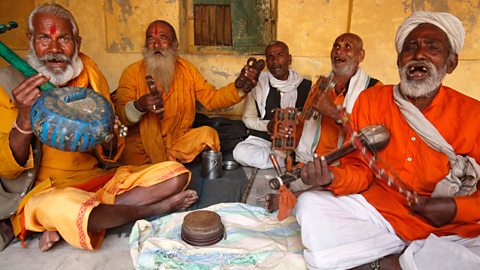Indian music

Indian music is easily recognised by the sound of its unique musical scales and instruments.
Traditionally, Indian musicians learn to play patterns of notes - ragas - by imitating and memorising music passed on from their teachers.
Most Indian music is based on:
- melody - rag
- rhythm - tal
- drone - sustained notes
The patterns of notes used in Indian music - ragas - are different to the scales used in Western music. They are associated with different times of day, season, mood and occasion.
Raag Shahana performed by Baluji Shrivastav
Indian instruments
In this video, Roopa Panesar introduces the sitar and the techniques she uses to create the unique sound of the instrument. She is joined by tabla player Sonny Singh to play the traditional piece 'Rag Suha in Taal Teentaal.'
Roopa Panesar plays the sitar, accompanied by the tabla
The sitar is a long-necked, stringed instrument with six or seven main strings that have twelve or more strings running underneath them. It has a distinctive sound as can be heard in the audio clip below.
Charu Keshi Rain by Nitin Sawhney, featuring Anoushka Shankar
The sitar is often accompanied by the tabla - a pair of drums played side by side while sitting on the floor. They have a high pitched sound. They can be played with the hand and fingertips to produce different sounds. Listen out for these different effects in the audio clip below, which also features the bansuri - a traditional flute made from bamboo.
Meeting performed by Talvin Singh and Rakesh Chaurasia
The role of the tabla is to keep time, although tabla players sometimes interact with the soloist.